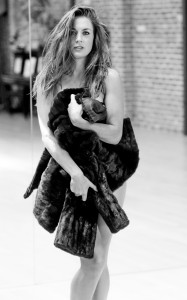Venus in Fur: The [Fore]play’s the Thing
It is easy to see why regional theatres have found Venus in Fur to be the most appealing of recent New York offerings to produce. It is a two-hander, with juicy roles for both performers (though, truth be told, the woman’s role is the one designed to win awards, as it did for Nina Arianda, who originated it off-Broadway and eventually won the Tony™ for her Broadway performance). It is written by David Ives, a proven commodity with audiences (his All in the Timing is a staple of regional theatre). And, it’s about sex, though with enough other “stuff” thrown in so as not to shake audience sensibilities too much.
San Diego REP’s production takes advantage of all of these pluses, and if it doesn’t achieve maximum potential it won’t disappoint its audiences, either.
The play is set in a rehearsal studio where a director (Jeff Meek) has been auditioning actresses for a play he has written. The play, it turns out, is based on the Nineteenth Century book, “Venus in Fur,” by Leopold von Sacher-Masoch, the man whose name became associated with the practice of sexual masochism. At the end of a long day that finds Thomas, the writer/director, complaining on the phone to his fiancé about the lack of fit between the women he’s auditioned and his vision of the role. He’s just about to depart when a bedraggled woman stumbles into the studio with a story about becoming lost and begs for a chance to audition.
The woman, who calls herself Vanda (Caroline Kinsolving), quickly demonstrates a knowledge of Sacher-Masoch’s novella that impresses Thomas, and the two proceed to act their way through the play, sometimes relying on the script while at other times improvising. Along the way, Thomas keeps taking calls from his fiancé, telling her that he’s on his way, and then going back to resume what by now has become a rather lengthy audition.
So, just who is this Vanda anyway? Mr. Ives never tells us for certain, but she has clearly figured out that anyone who would want to write a play about a sexual fetish probably harbors such a fetish. And she’s clearly not only right but she’s got the kinds of psychological knowledge to elicit, bit by bit, the fetish to emerge from a tired director whose chief complaint is that none of the actresses he’s seen “get” the work. Vanda gets it, to the point where along the way Aphrodite, Venus’ name in Greek mythology, is invoked. In the Greek tradition one of the Aphrodite stories concerns her love affair with Adonis, the world’s most perfect male. Could Thomas’ fantasy involve achieving sexual perfection by being disciplined by a beautiful woman?
Vanda also casually mentions that she was a prostitute at one point in her life. All the better, from the male point of view. Sacher-Masoch maintained both a conventional marriage as well as a dominatrix mistress, and Thomas’ continual telephone reassurances to his fiancé could play into such a fantasy. Perhaps Vanda is even a figment of Thomas’ imagination, providing him the satisfaction that he claimed the other actresses could not.
But, to the audience Vanda is quite real, and co-directors Kim Rubinstein and Sam Woodhouse have created a hyper-realistic staging in order to draw the audience in. They start by configuring the flexible Lyceum Space Theatre as in-the-round, which puts the audience quite close to the action. In fact, Robin Sanford Roberts’ scenic design includes playing spaces built into areas where the audience is seated, causing some audience members to turn to see the action (albeit only briefly). The directors also stage their actors to use the edges of the stage quite a bit, continually sending a message to the audience that the action is happening right before their eyes.
Hyper-reality continues with the other technical elements. The rehearsal space has its own lighting system, and Vanda knows that she can adjust the lighting to fit the mood of what is coming next. Lonnie Rafael Alcaraz’s lighting design accommodates such changes and makes it look as though Vanda knows exactly what she’s doing to set to proper tone. Jennifer Brawn Gittings’ costumes eschew fantasy in favor of evoking emotion from ordinary existence (clearly, the publicity photos accompanying this review were taken near the start of rehearsals, as they portray a much more fantasy-based vision than does the actual production). George Yé’s sound design provides a route into the mental fantasy world to which Thomas eventually surrenders, as it mixes realistic sounds with those that might have been lifted from horror films. [php snippet=1]Mr. Meek might be too docile for some tastes. He is certainly not the domineering misogynist that one might have expected from a summary of Sacher-Masoch’s work. Ms. Kinsolving catches nicely the many shifts Vanda makes between actress and fantasy creature. She, too, is not domineering, and as a result she is perhaps all the more seductive and dangerous as one determined to feed a fantasy for her own purposes. It’s a subtle performance in a role that could be showy, but it works in blending with the lower-key approach taken by Mr. Meek.
As in many sexual fantasies, there’s a lot of foreplay but very little sex. But, to coin a phrase, the foreplay’s the thing.
[box] Venus in Fur runs through December 8 at the Lyceum Space Theatre, underneath Horton Plaza in downtown San Diego. Performances run Wednesday through Sunday (no performance Thanksgiving Day), and matinees are scheduled on Saturdays and Sundays. Parking is available in the Horton Plaza structure, and the theatre provides validations in the lobby. Ticket prices are $39 – $59. See below for telephone and Internet ordering information.
DOWNLOAD CAST AND CREDITS HERE [/box]

In addition to reviewing theatre for San Diego Story, Bill also reviews for TalkinBroadway.com. He is a member of the San Diego Theatre Critics Circle and the American Theatre Critics Association. Bill is an emeritus professor in the School of Journalism and Media Studies at San Diego State University.




